With 63 U.S. national parks spanning a variety of ecosystems, the U.S. National Park System offers seemingly endless opportunities for outdoor adventure. Yet most visitors tend to gravitate toward our most iconic and well-known ones. In 2024, more than 50 percent of all recreational visits to a national park were to the 10 most visited: Great Smoky Mountains, Zion, Grand Canyon, Yellowstone, Rocky Mountain, Yosemite, Acadia, Olympic, Grand Teton, and Glacier.
While each of those is popular for good reason, many others are underrated and undervisited—whether because they’re lesser-known, more far-flung, or simply overshadowed by more famous nearby parks.
As overtourism becomes a major concern for many travelers heading to national parks, consider adding one of these 13 underrated U.S. national parks to your must-visit list.
Related: How to Visit the National Parks for Free in 2025
1. Wrangell–St. Elias National Park & Preserve
Alaska
Eight of Alaska’s national parks combined accounted for less than 2 percent of all U.S. national park visits in 2024. Roughly 90 percent of those visitors headed to Denali, Glacier Bay, and Kenai Fjords, leaving the others—such as the stunning Wrangell–St. Elias National Park & Preserve—largely unexplored.
With 13 million acres of land in its bounds, Wrangell–St. Elias is the largest U.S. national park, and those who brave the drive or flight will have a rare chance to explore a vast and diverse array of arctic wilderness—wilderness that is larger than Yellowstone National Park, Yosemite National Park, and Switzerland combined. Highlights include several of the highest peaks in the nation, including the 18,008-foot-tall Mount St. Elias; expansive ice fields and large glaciers, like 53-mile-long Nabesna Glacier; and Mount Wrangell, an active volcano that has emitted smoke (but not erupted) several times in the past few decades. The park’s size and range of terrain offer ample ways to explore, be it hiking, climbing, rafting, or fishing.
How to visit
Most visitors will drive the 60-mile-long, unpaved McCarthy Road from Chitina, although Wrangell Mountain Air also offers three daily (in the summer) flights into the park. Once there, stay a few nights at the Ultima Thule Lodge. Guests have access to daily fly-out adventures on small prop planes, allowing them to explore otherwise hard-to-access corners of the park.

Congaree National Park earned UNESCO Biosphere Reserve status for its biodiversity, natural resources, and cultural heritage.
Photo by Michele Korfhage/Shutterstock
2. Congaree National Park
South Carolina
Congaree National Park in South Carolina is best known for its large collection of old-growth, bottomland hardwood trees. The park is a cathedral of colossal trees draped in Spanish moss, where sunlight filters through a dense green canopy and the air hums with cicadas. The park floods seasonally, creating a dreamy, swampy world in which you can take a guided tour down Cedar Creek canoe trail. It’s one of the best places in the Southeast to spot barred owls, river otters, and, in late spring, the surreal synchronous fireflies that light up the woods between mid-May and mid-June. But be warned: The park sits on a floodplain fed by the Congaree and Wateree rivers, and it can be swampy (in other words, full of mosquitoes) in warmer months. Spring and fall are the best times to visit.
How to visit
Two hours from Charleston, and half an hour from Columbia, South Carolina, Congaree is easily visited as a day or weekend trip from either city. If you’re staying the night, make a reservation at one of the park’s two front-country campgrounds, Longleaf Campground and Bluff Campground.
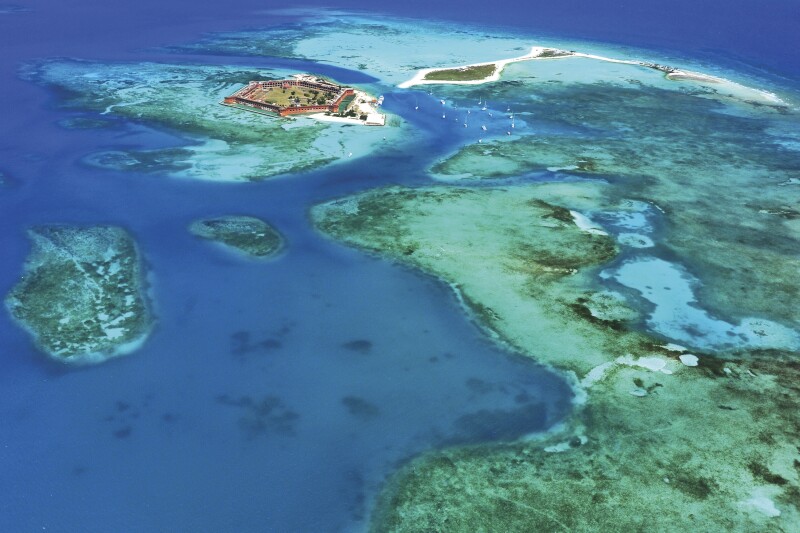
Learn about nature and the history of Fort Jefferson at Dry Tortugas National Park.
Photo by Florida Keys News Bureau
3. Dry Tortugas National Park
Florida
Located 70 miles offshore from Key West in the Gulf of Mexico, Dry Tortugas National Park is often passed over in favor of Florida’s more well-known and easy-to-reach Everglades National Park. Although a neighbor of the Everglades, Dry Tortugas is different. This park consists mostly of open water, with coral reefs and seven small islands, putting marine life at the center of its attractions.
Visitors can explore its unique beauty by snorkeling, diving, or kayaking—as well as learning about the history of Fort Jefferson, built in the 1800s on Garden Key. For the few who choose to spend the night and camp, the remoteness of the islands offers incredible stargazing and afternoons of crowd-free swims once the day-trippers have returned to shore.
How to visit
The Yankee Freedom ferry, which departs Key West at 8 a.m. daily, is the easiest way to access the park. Day trips with the ferry start at $235 per adult, and a round-trip ferry ride plus a camping pass is $240. Camping is the only way to spend the night here, and you must have a reservation in advance. It’s also wise to book your ticket several weeks (or months) before your trip, especially if you want to stay overnight.

Voyageurs National Park is far enough north to see the aurora borealis.
Photo by BlueBarronPhoto/Shutterstock
4. Voyageurs National Park
Minnesota
With only 199,030 visitors in 2024, Voyageurs National Park along the Canadian border in Minnesota doesn’t always get the attention it deserves, despite being a wonderland for aquatic activities as well as a certified International Dark Sky Park. Nearly 40 percent of the park is water, a series of interconnected waterways plus lakes including Rainy, Kabetogama, Namakan, and Sand Point. There is evidence that for more than 10,000 years, humans have centered life in this area around the waterways, using them for fishing and foraging and as transportation corridors—all of which still draw travelers today.
As for stargazing, Voyageurs offers visitors a rare opportunity to glimpse the aurora borealis in the lower 48. But even without the northern lights, you should still expect a pretty spectacular sight on clear nights.
How to visit
Visitors should spend the night, either at one of the park’s many campgrounds (some drive-in, some backcountry, and many only accessible by canoe) or on the water in a houseboat (permit required). Ebel’s, in the gateway community of Ash River, provides houseboat rentals from which you can navigate and explore Voyageur’s waterways and lakes.
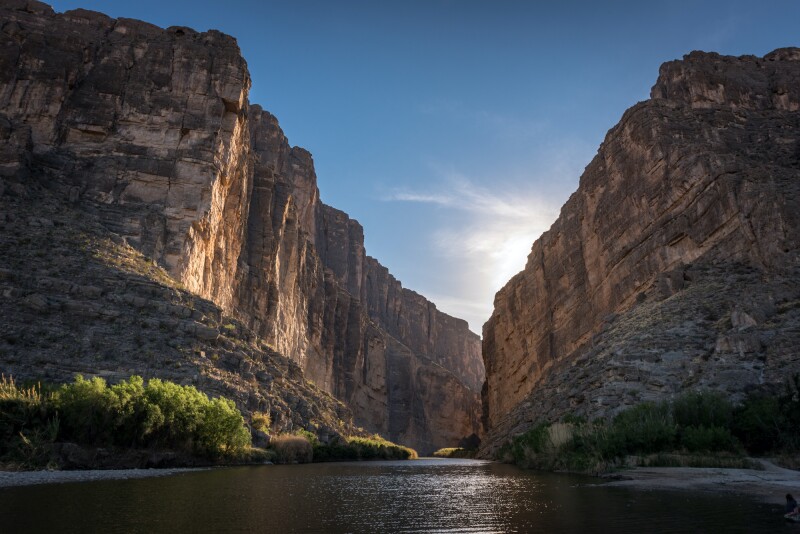
Big Bend National Park features three unique landscapes, one centered around the Rio Grande.
Photo by Stanley Ford
5. Big Bend National Park
Texas
Norman Aynbinder, president and CEO of luxury tour operator Excursionist, says Big Bend National Park is “underrated because of the location. . . . It’s definitely one of the harder parks to get to.” But this park in the southwest corner of Texas is a gem worth visiting, no matter the season. “Unlike some parks that are more limited in the season,” he says, “you can visit [Big Bend] year-round.”
Big Bend is one of the most biodiverse parks in the United States, home to more than 450 species of birds, 75 species of mammals, 22 species of lizards, as well as three distinct landscapes centered around the Chisos Mountains, the Chihuahuan Desert, and the Rio Grande. Vast, rugged, and varied, the park offers plenty of ways to explore—whether by a hike to the park’s historic hot springs, a multiday canoe trip down the Rio Grande, or bird-watching along the 5.5-mile Window Trail.
How to visit
Since Big Bend is only about 90 minutes from the small, artistic town of Marfa, they “make for a great combination,” Aynbinder says, especially as part of a West Texas road trip.
For a more under-the-stars experience, consider a luxury safari tent or yurt at the bright and bohemian El Cosmico in Marfa. Within the park are several options for drive-in (reservations recommended) and backcountry camping.
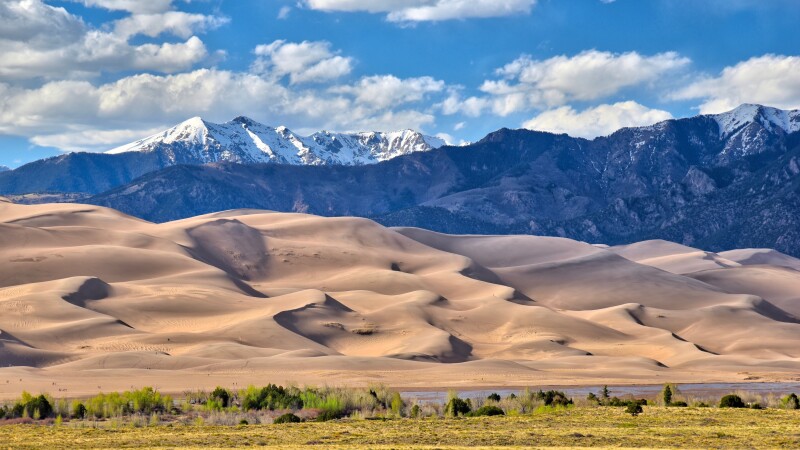
Head to Great Sand Dunes National Park to see sand dunes against dramatic mountain landscapes.
Photo by Eric Brinley/Shutterstock
6. Great Sand Dunes National Park
Colorado
“One of my favorite [national parks] is . . . Great Sand Dunes National Park in southern Colorado,” tour company founder and parks expert Marty Behr of Abercrombie & Kent told Afar in an interview. True to its name, the park is home to some of the tallest sand dunes in North America, formed by sand from southwestern deserts being blown up against the adjacent Rocky Mountains. “So it’s sand dunes up against 14,000-foot peaks [as well as] marshlands and wetlands with a huge variety of birds. It’s like three ecosystems in one—extraordinary and diverse. They don’t allow any motorized vehicles, but you can hike 750 feet up [the dunes] and slide down on a disk,” says Behr.
How to visit
Colorado Springs (to the northeast), Durango (to the west), and Santa Fe (to the south) are the closest cities to the park; all are about three hours away. There are limited accommodation options near Great Sand Dunes National Park, but you can camp at Piñon Flats Campground within the park (reservations required) and at several hike-in, backpacking campgrounds.
For a less rugged place to sleep, Behr says, “Most of our [Abercrombie & Kent] guests either stay in Santa Fe or at Vermejo Ranch, a Ted Turner Reserve” in New Mexico.

Not far from Arches National Park, Canyonlands has many of its own, such as the Mesa Arch.
Photo by Jnjphotos/Shutterstcok
7. Canyonlands National Park
Utah
Although considered one of Utah’s “Big 5,” Canyonlands is the least visited of the five—despite its proximity to the ever-popular Arches National Park and its easy access from Moab. At about 338,000 acres, Canyonlands is much more vast than Arches (about 77,000 acres), with “some of the best rafting, hiking, Jeep tours, and canyoneering,” according to Excursionist’s Aynbinder. The park also has plenty of the iconic slot canyons for which Utah is well-known.
The Colorado River snakes through Canyonlands, making it a fantastic alternative to the nearby Grand Canyon for rafting trips. “The Grand Canyon rafting tours are hard because they’re crowded, booked up for years, but you can get just as stunning views in Canyonlands [and] with fewer people,” Aynbinder says.
How to visit
You can visit and camp in Canyonlands on your own, but you’ll get more access if you go with a tour, like those organized by Excursionist, which can bring you to hard-to-access parts of the park with a 4x4 Land Cruiser.
Alternatively, Ulum’s glamping property in Moab sits right between Arches and Canyonlands. The luxury spot offers complimentary programming, including yoga classes and watercolor painting sessions.
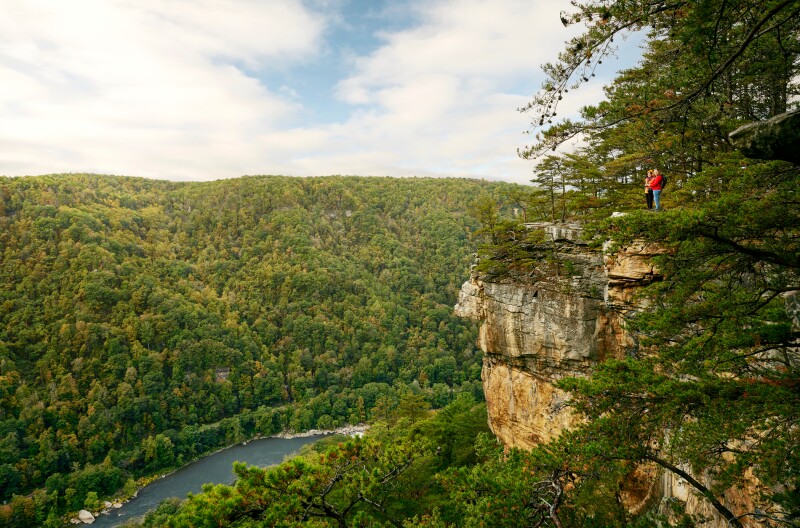
TK
Photo Courtesy of West Virginia Tourism
8. New River Gorge National Park
West Virginia
In early 2021, the New River Gorge, formerly a national river, became a national park and preserve, making this West Virginia park the newest in the United States. With 1.8 million visitors in 2024, it’s the 17th most visited park—yet it’s still freshly on many outdoor enthusiasts’ radars.
Encompassing more than 70,000 acres of land, this rugged Appalachian canyon has something for everyone: rock-climbing routes on sandstone cliffs for climbers of all levels, rafting along 53 miles of whitewater that include Class IV and V rapids, and hundreds of miles of hiking and mountain-biking trails.
How to visit
New River Gorge is an hour-long drive from Charleston, West Virginia. To spend the night, pick one of several campgrounds within the park. Outside the park, you’ll find additional camping options at privately owned campgrounds, such as the cyclist-friendly Arrowhead Bike Farm.
For a more cozy cabin-in-the-woods experience, book one of the rentals at Adventures on the Gorge, an expansive, family-friendly adventure resort outside the park.
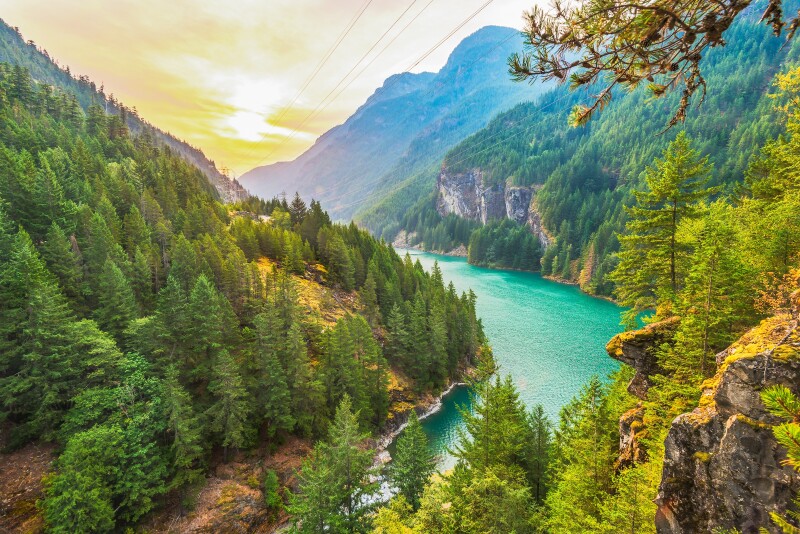
Diablo Lake in North Cascades National Park offers memorable views.
Photo by Checubus/Shutterstock
9. North Cascades National Park
Washington
North Cascades National Park on the Canadian border in Washington State is known as the American Alps, offering waterfalls, high peaks, and dramatic, snow-tipped mountains. It’s also home to more than 500 lakes and ponds—some of which you can boat in.
Despite its beauty, it had only 16,485 visitors in 2024, making it the second least-visited U.S national park (behind only Gates of the Arctic National Park in northern Alaska)—although this is in part because the park is open only during the summer. State Highway 20 is usually closed by October 1. “When it’s open, people really go for spectacular hiking, but there is also whitewater rafting and horseback riding,” says Abercrombie & Kent’s Behr.
How to visit
Campers have a variety of options within North Cascades National Park: drive-in (reservations recommended), boat-in, and backcountry (permits required). For a less rugged accommodation option, Behr recommends Sun Mountain Lodge, “a beautiful property [in Winthrop] up on a hillside with gorgeous views, a rustic feel, and a good restaurant.”

Pinnacles National Park is an easy day trip for hikers and climbers.
Photo by SnapASkyline/Shutterstock
10. Pinnacles National Park
California
With nine national parks, California has more than any other state. Lesser-known Pinnacles National Park—roughly 2.5 hours south of San Francisco—saw .38 percent of all national park visits in 2024. It’s home to a striking and unique landscape of rock spires and caves formed by volcanic eruptions as worthy of exploring as the vast deserts of Joshua Tree and dunes of Death Valley.
Not surprisingly, the unique rock formations throughout the park make Pinnacles a popular destination for climbers, especially in cooler months. Those who prefer to stay grounded can traverse miles of trails that take them past the formations, through lava tunnels, and to the top of mountain peaks for scenic vistas. If you have only one day, check out the Condor Gulch to High Peaks Loop trail, a challenging five- to six-mile loop through the heart of the Pinnacles rock formations.
How to visit
If you want to spend the night, your best option is to book a site at the Pinnacles Campground on the east side of the park. Hotels and Airbnbs near the park are sparse, but it’s a relatively easy day trip from Monterey, Carmel Valley, or San Jose. Just be sure to choose your route carefully; the east and west entrances of the park connect by trail, not road, and you can’t drive through the park to reach the other access point.

Lehman Caves is only one feature among the nearly 80,000-acre Great Basin National Park.
Photo by IrinaK/Shutterstock
11. Great Basin National Park
Nevada
Did you know there’s still a glacier in Nevada? It’s the Wheeler Peak Glacier, tucked beneath the 13,063-foot Wheeler Peak found in Great Basin National Park. Here you can walk among some of the oldest living organisms on Earth—the bristlecone pines—and stargaze at one of the darkest skies in the country. However, one of the most exciting things you can do in Great Basin is go underground. The park has an extensive limestone caving system known as Lehman Caves, where stalactites and stalagmites twist and shimmer. To see them, you’ll need to be on a ranger-led tour, which is 90 minutes and offered multiple times throughout the day.
How to visit
It’s roughly a four-hour drive from Salt Lake City or five hours from Las Vegas to Great Basin. The National Park Service recommends downloading a park map on your phone, as Great Basin has little to no cell phone coverage. Among the accommodations near Great Basin, beyond the designated campgrounds within the park, is a small clutch of Airbnbs in Baker, Nevada, and some cozy motels, such as Stargazer Inn and Hidden Canyon Retreat.
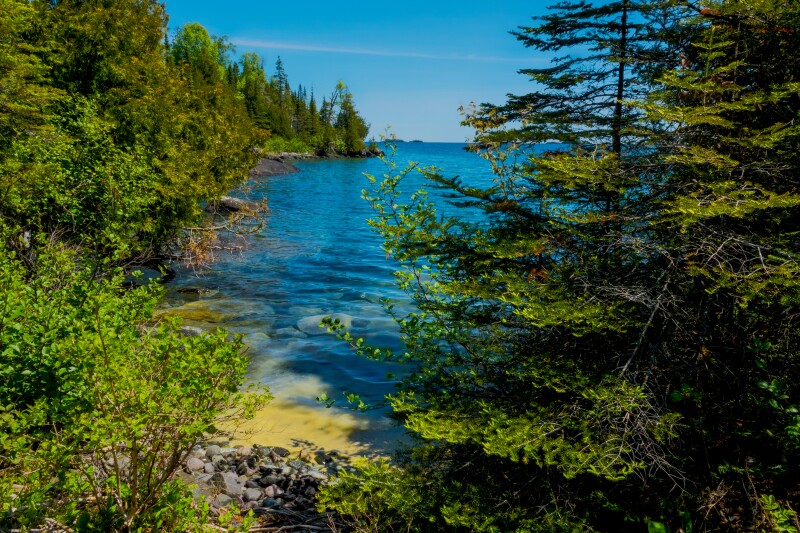
Isle Royale National Park is among the natural wonders along Lake Superior in Michigan.
Photo by Arlene Waller/Shutterstock
12. Isle Royale National Park
Michigan
Isle Royale is a group of roughly 400 islands huddled in the northwestern corner of Lake Superior, near the border with Canada. Exploring the park is done entirely by boat or by foot—no cars are allowed. You can bring your own watercraft or rent a canoe from Rock Harbor or Windigo. One of the most popular paddles is the Chain of Lakes trail, which requires a fair amount of portaging but offers jaw-dropping views of secluded lakes and old-growth forests. The park is also a solid spot for freshwater scuba diving thanks to the many shipwrecks within the depths of its waters.
How to visit
You’ll need to take a seaplane, ferry, or private boat to reach Isle Royale—after all, it is in Lake Superior. The park is open only from mid-April to the end of October. Rock Harbor Lodge offers 60 comfortable rooms on the northeastern edge of Isle Royale. There are private rooms within the main lodge as well as a variety of cabins scattered throughout the property. The staff can help guests arrange water taxis, sightseeing tours, and fishing charters.

National Park of American Samoa includes parts of the islands of Tutuila, Ta’ū, and Ofu.
Photo by Danita Delimont/Shutterstock
13. National Park of American Samoa
American Samoa
Spanning three islands in the South Pacific, some 2,600 miles southwest of Hawai‘i, the National Park of American Samoa is the most challenging place to reach in the national park system. (It’s also the only park south of the equator.) But here, you’ll find crystal-clear waters (filled with roughly 1,000 different species of fish) that meet white-sand beaches beside jungle-covered mountains. Snorkeling, relaxing on the beach, and hiking one of the trails are some of the most popular ways to experience the park.
How to visit
Hawaiian Airlines is the only carrier that currently has flights to American Samoa that depart from Honolulu. Once in American Samoa, you can rent a car or take public transportation into the park. Camping is prohibited within the park, so you’ll have to find lodging elsewhere. Taumeasina Island Resort and Sinalei Reef Resort & Spa are among the very reliable high-end resort options.
This article was originally published in 2021 and most recently updated on April 14, 2025, with current information. Jessie Beck contributed to the reporting of this story.











